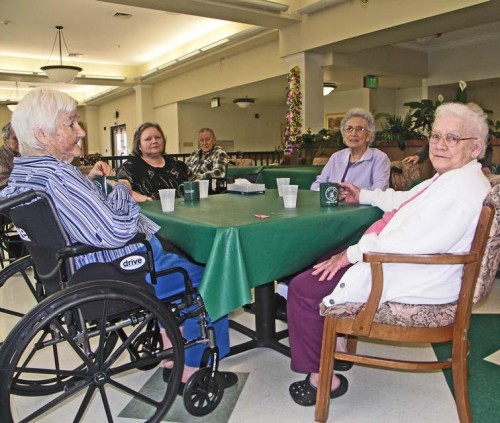
Papetra Guidroz
March 18, 2011Tues., March 22
March 22, 2011The cost of growing older has increased. The general population has aged on average 10 to 15 years longer for life expectancy than it did 65 years ago, and 79 million baby boomers – the first group turned 65 this year – are quickly entering the ranks of mature adulthood.
The U.S. Census Bureau has estimated that by the year 2050, the number of citizens 65 and older will account for 21 percent of the total population.
Advances in health services as well as sheer numbers will boost the demand for senior care facilities – ranging from independent living to assisted living to skilled nursing – beyond what has ever been previously experienced. The question for many will soon become, “Can I afford it?”
According to the Centers for Disease Control and Prevention, the number of senior care facilities – many professionals in the field no longer like the term nursing home due to a negative connotation – actually decreased from 16,398 properties in 1995 to a total of 15,700 in 2009.
CDCP figures show that Louisiana, based on the latest surveys, has a total 282 senior care facilities – down from 335 nearly 15 years earlier.
Overall current occupancy levels for senior living facilities nationally are estimated to be 66 percent, and at 58 percent in Louisiana.
Some industry insiders contend that profit making luxury retirement communities offering what is known as continued care, and ranging in options from independent living to assisted and skilled living at the same facility, grew popular during the 1980s and 1990s. Yet in less than a decade those living communities appear to have lost favor among newer prospective residents primarily due to the cost that can run in average from $5,000 to $7,000 a month.
The Lafourche Home for the Aged is a non-profit skilled nursing facility in Thibodaux. According to accounts payable director Susan Cortez, the amount paid for accommodations depends on categories in which applicants might fit.
“[What you can afford] depends on each person’s financial situation as far as what services you qualify for,” Cortez said.
Because the Lafourche Home for the Aged is non-profit its residents rely heavily on Medicare and Medicaid to cover their living costs. With that is the criterion that couples have a maximum amount of resources at $104,000. For a single person the maximum amount of resources allowed to receive federal assistance is $2,000.
“[Our prices range] anywhere from $140 to $156 per day,” Cortez said. “That’s for total care. Those prices are for intermediate care and private pay.”
When it comes to assisted living – persons who basically do well on their own but need help when it comes to tasks such as cooking or laundry – in Louisiana, most facilities do not benefit from government funding and are covered by private pay.
“I would say the [overall price range for assisted living] is $1,800 to $3,000 a month,” said Maison Jardin Senior Living Administrator Emily Berry. The Morgan City facility charges its residents in the middle range of that scale, according to Berry. “Our regular one bedroom is $2,275 a month. We are lower than most.”
Berry said that in terms of assisted living rates, it is common for such facilities to offer residents an apartment, housekeeping services, three complete meals, snacks and various activities. Additionally they are offered assistance with medications and around-the-clock staff to meet their needs.
“I think there is a lot of misconception on what is involved,” Berry said. “Twenty-two seventy-five sounds expensive. But when you look at it you don’t have anyone doing your lawn at home anymore, if you have a mortgage you are going to be paying for that, utilities are included in the monthly rent so you don’t have to worry about paying those bills, and there is staff in our buildings 24 hours a day. You have to take those comparisons and compare them.”
Steven Boulware is administrator of the family owned Chateau Terrebonne in Houma. As a skilled nursing facility, this business has a primary focus on helping rehabilitate seniors following a hospital stay, in addition to residents that require long term constant care.
“Medicare helps us [and] covers a lot of the rehabilitation costs. We have some private pay [clientele] and we are doing certified [cases] with Medicare and Medicaid,” Boulware said.
“[When it comes to skilled nursing care] there are 60 Medicare rates that any person can fall into on any given day. That can range from $200 a day to $600 a day. It depends on the services we provide,” Boulware said.
Skilled nursing care is commonly the most expensive level of senior care because it can involve almost any kind of treatment from occupational therapy to physical and even speech therapy. It also is a level of care reserved for those persons who can do very little for themselves.
“Nursing homes have become a bit of a revolving door in the last 10 to 15 years,” Boulware said. “We have a much sicker clientele. We have much more high acuity nursing going on. We have a lot more bed bound patients and a lot more wheelchair bound residents.”
Elderly residents in senior care facilities might seem to be in worse physical condition than in the past. But that, according to the experts, is only because it is an older and in turn frailer population involved than in the past.
Certified financial planner John Sirois said it is difficult to know how many Americans are prepared for the cost of living in a senior care facility, but added that those who are unprepared are definitely a majority.
“The resource amount, as far as what it is going to cost per month obviously will depend on where the individual is going to be staying,” Sirois said from his office in Houma. “You’re looking at $3,500 a month on up. In Louisiana we have some of the lowest rates as far as nursing home rates in the nation. In other states you’re looking at three times that amount.”
Sirois and retirement community insiders said that realistically, persons planning on entering any level of retirement care should anticipate on average $4,000 a month for care to match their needs. In some parts of the country that amount can reach $10,000 per month.
“Long-term care is not cheap,” Sirois said. “We are advising people at a younger and younger age to purchase long term care insurance while the premiums are more affordable [to them].”
Long-term insurance premiums generally cost less for persons in their 40s than for those in their 60s who decide to purchase coverage.
According to elderlaw.com, one of the problems when shopping for long-term care coverage it that it is almost impossible to compare what different companies offer. Additionally, the prospective policyholder generally has no idea for how long coverage would be needed, which also impacts rates.
Policies are typically written to cover a specific dollar amount per day. So a total benefit package of $200,000 might only allow for $200 a day.
Other factors come into play as well, including limits on what is covered, inflation riders, claim history, and an elimination period. Every element adds to the overall cost.
Currently the national average long-term care insurance costs have premiums of about $1,877 per year for a 55-year-old person. That amount will increase to more than $2,000 a year for those that initially purchase it at the age of 65, and will be about $2,600 a year for the newly insured at age 79.
Sirois said that while some aging Americans have been able to plan well financially they will be able to cover whatever senior living costs the need. Some have planned ahead and may have to take a reduction in their standard of living to cover their living needs as the age. But the majority of aging adults will find it difficult to meet the financial demands of getting old.
“When looking at the price [for a retirement care facility] they need to add up all the expenses they would be having at home and see where they would be saving,” Berry said.
While some facilities will increase rates on a monthly basis, Berry and Cortez said their rates, as examples, increased this year after holding steady for four and two years respectively.
“There are those people who fall into that gray area [in terms of being able to afford proper care],” Boulware said. “But usually you can find a place for somebody.”
“As it stands now, Medicaid [in most cases] will pick up the tab,” Sirois said. “How are they going to revamp that in the future? How are people [who are not prepared] going to afford it? Your guess is as good as mine.”
Clockwise from left, Dorothy Picou, Ann Foley, Irene Meadows and Ruth Raffery consider their afternoon activities while waiting for lunch at Chateau Terrebonne. MIKE NIXON












